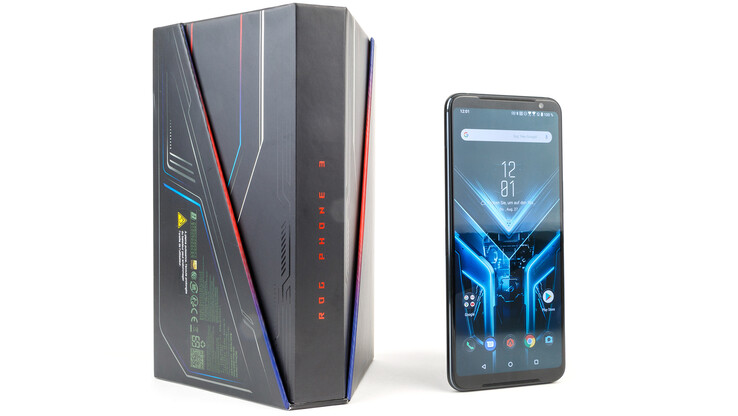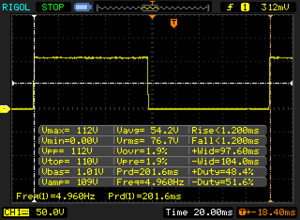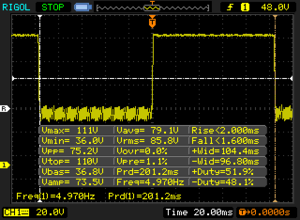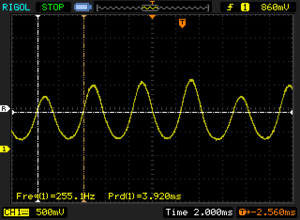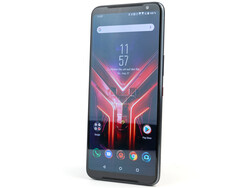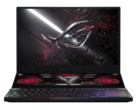Asus ROG Phone 3 Review - The smartphone with the extra performance
After we already tested the Strix Edition of the ROG Phone 3, we are now finally going to review the better-equipped version. Asus' ROG Phone 3 uses the faster Snapdragon 865+ and offers a larger storage capacity. Either 12 GB of working memory and 512 GB of internal storage or a model with 16 GB of RAM are available. We find the surcharge of 100 Euros for the additional 4 GB of working memory to be steep
In contrast to the Strix version, Asus not only offers a faster SoC and more memory, but also more performance in mobile communications. The theoretical download speeds for LTE increase up to 2.0 GBit/s (Cat. 20) and for 5G up to 4.4 GBit/s (Strix Edition: 1.8 and 4.0 GBit/s). The number of supported mobile bands is also increased. There are two additional bands for 3G, 5G can continue to use seven and these are even doubled to 28 for LTE
The ROG Phone 3 (ZS661KS) should nominally cost 999 Euros (~$999), but it is now available for much less. We focus on the additional performance provided by the faster processor in this review. The other test areas can be read in detail in the Strix Edition article.
Comparison devices
Bewertung | Rating Version | Datum | Modell | Gewicht | Laufwerk | Groesse | Aufloesung | Preis ab |
|---|---|---|---|---|---|---|---|---|
| 89 % v7 (old) | v7 (old) | 12 / 2020 | Asus ROG Phone 3 SD 865+ (Plus), Adreno 650 | 240 g | 512 GB UFS 3.1 Flash | 6.59" | 2340x1080 | |
| 89.1 % v7 (old) | v7 (old) | 09 / 2020 | Asus ROG Phone 3 Strix Edition SD 865, Adreno 650 | 240 g | 256 GB UFS 3.1 Flash | 6.59" | 2340x1080 | |
| 85.3 % v7 (old) | v7 (old) | 06 / 2020 | Xiaomi Black Shark 3 Pro SD 865, Adreno 650 | 253 g | 256 GB UFS 3.0 Flash | 7.10" | 3120x1440 | |
| 84.7 % v7 (old) | v7 (old) | 10 / 2020 | Nubia RedMagic 5S SD 865, Adreno 650 | 218 g | 128 GB UFS 3.1 Flash | 6.65" | 2340x1080 |
Performance - ROG Phone 3 is the ultimate gamer
The Asus ROG Phone 3 is powered by the Snapdragon 865+ and has 12 GB of LPDDR5 working memory in our test version. In contrast to the Snapdragon 865 without Plus, this also means a powerful Prime core, three performance cores, and four power-saving Cortex-A55 cores. However, the Plus model has the stronger Prime core with up to 3.1 GHz (SD865: max. 2.84 GHz)
This is particularly noticeable in the benchmarks due to a higher single-core performance, which is around 9% higher. The increase is lower by 4% when all cores are used, which is relatively congruent in both Geekbench and 3DMark
The integrated graphics unit Adreno 650 also gets a higher clock rate, which is increased from a maximum of 587 MHz in the Snapdragon 865 to up to 650 MHz, which gives the ROG Phone 3 a performance increase of up to 10%. All in all, the ROG Phone 3 is even a bit faster than other smartphones with the same SoC
However, this is not noticeable in games because the high performance is hardly demanded by any game. Only Genshin Impact cannot be played at a constant 60 FPS, but shows several frame drops. It is quite possible that this can be improved with software updates
The test of PUBG Mobile also shows a different behavior than with the Strix Edition. The HD setting is now limited to 40 FPS, but a full 90 FPS is available with the graphics details. The still young Ultra HD setting is handled effortlessly and stably by the ROG Phone
| PCMark for Android - Work 2.0 performance score (sort by value) | |
| Asus ROG Phone 3 | |
| Asus ROG Phone 3 Strix Edition | |
| Xiaomi Black Shark 3 Pro | |
| Nubia RedMagic 5S | |
| Average Qualcomm Snapdragon 865+ (Plus) (12355 - 14979, n=6) | |
| Asus ROG Phone 3 | Asus ROG Phone 3 Strix Edition | Xiaomi Black Shark 3 Pro | Nubia RedMagic 5S | Average 512 GB UFS 3.1 Flash | Average of class Smartphone | |
|---|---|---|---|---|---|---|
| AndroBench 3-5 | -2% | -15% | -17% | 27% | 48% | |
| Sequential Read 256KB (MB/s) | 1710 | 1697 -1% | 1398 -18% | 1348 -21% | 1867 ? 9% | 2213 ? 29% |
| Sequential Write 256KB (MB/s) | 772 | 770 0% | 658 -15% | 674 -13% | 1303 ? 69% | 1829 ? 137% |
| Random Read 4KB (MB/s) | 274.3 | 266.8 -3% | 218.2 -20% | 213.3 -22% | 288 ? 5% | 293 ? 7% |
| Random Write 4KB (MB/s) | 280.6 | 268.5 -4% | 261.5 -7% | 243.5 -13% | 354 ? 26% | 335 ? 19% |
Gaming-Benchmarks
More measurements
Communication
| Networking | |
| iperf3 transmit AX12 | |
| Xiaomi Black Shark 3 Pro | |
| Nubia RedMagic 5S | |
| Asus ROG Phone 3 | |
| Asus ROG Phone 3 Strix Edition | |
| iperf3 receive AX12 | |
| Asus ROG Phone 3 | |
| Asus ROG Phone 3 Strix Edition | |
| Nubia RedMagic 5S | |
| Xiaomi Black Shark 3 Pro | |
Display
| |||||||||||||||||||||||||
Brightness Distribution: 88 %
Center on Battery: 625 cd/m²
Contrast: ∞:1 (Black: 0 cd/m²)
ΔE ColorChecker Calman: 2.6 | ∀{0.5-29.43 Ø4.79}
ΔE Greyscale Calman: 2.5 | ∀{0.09-98 Ø5}
99.9% sRGB (Calman 2D)
Gamma: 2.22
CCT: 6750 K
Display Response Times
| ↔ Response Time Black to White | ||
|---|---|---|
| 2.4 ms ... rise ↗ and fall ↘ combined | ↗ 1.2 ms rise | |
| ↘ 1.2 ms fall | ||
| The screen shows very fast response rates in our tests and should be very well suited for fast-paced gaming. In comparison, all tested devices range from 0.1 (minimum) to 240 (maximum) ms. » 11 % of all devices are better. This means that the measured response time is better than the average of all tested devices (20.3 ms). | ||
| ↔ Response Time 50% Grey to 80% Grey | ||
| 3.6 ms ... rise ↗ and fall ↘ combined | ↗ 2 ms rise | |
| ↘ 1.6 ms fall | ||
| The screen shows very fast response rates in our tests and should be very well suited for fast-paced gaming. In comparison, all tested devices range from 0.165 (minimum) to 636 (maximum) ms. » 13 % of all devices are better. This means that the measured response time is better than the average of all tested devices (31.7 ms). | ||
Screen Flickering / PWM (Pulse-Width Modulation)
| Screen flickering / PWM detected | 255.1 Hz | ≤ 99 % brightness setting | |
The display backlight flickers at 255.1 Hz (worst case, e.g., utilizing PWM) Flickering detected at a brightness setting of 99 % and below. There should be no flickering or PWM above this brightness setting. The frequency of 255.1 Hz is relatively high, so most users sensitive to PWM should not notice any flickering. However, there are reports that some users are still sensitive to PWM at 500 Hz and above, so be aware. In comparison: 53 % of all tested devices do not use PWM to dim the display. If PWM was detected, an average of 8152 (minimum: 5 - maximum: 343500) Hz was measured. | |||
Loudspeaker
Asus ROG Phone 3 audio analysis
(+) | speakers can play relatively loud (89.9 dB)
Bass 100 - 315 Hz
(-) | nearly no bass - on average 18.8% lower than median
(±) | linearity of bass is average (7% delta to prev. frequency)
Mids 400 - 2000 Hz
(+) | balanced mids - only 3.9% away from median
(+) | mids are linear (4.2% delta to prev. frequency)
Highs 2 - 16 kHz
(+) | balanced highs - only 3.4% away from median
(+) | highs are linear (3.2% delta to prev. frequency)
Overall 100 - 16.000 Hz
(+) | overall sound is linear (12.9% difference to median)
Compared to same class
» 0% of all tested devices in this class were better, 0% similar, 99% worse
» The best had a delta of 11%, average was 35%, worst was 134%
Compared to all devices tested
» 12% of all tested devices were better, 3% similar, 86% worse
» The best had a delta of 4%, average was 24%, worst was 134%
Xiaomi Black Shark 3 Pro audio analysis
(+) | speakers can play relatively loud (84.3 dB)
Bass 100 - 315 Hz
(-) | nearly no bass - on average 70% lower than median
(+) | bass is linear (0% delta to prev. frequency)
Mids 400 - 2000 Hz
(-) | nearly no mids - on average 70% lower than median
(+) | mids are linear (0% delta to prev. frequency)
Highs 2 - 16 kHz
(-) | nearly no highs - on average 70% lower than median
(+) | highs are linear (0% delta to prev. frequency)
Overall 100 - 16.000 Hz
(-) | overall sound is not linear (117.6% difference to median)
Compared to same class
» 87% of all tested devices in this class were better, 7% similar, 5% worse
» The best had a delta of 11%, average was 35%, worst was 134%
Compared to all devices tested
» 96% of all tested devices were better, 2% similar, 2% worse
» The best had a delta of 4%, average was 24%, worst was 134%
Battery life
Pros
Cons
Verdict - A sensible upgrade not only for enthusiasts
Visually, there are no major differences to the Strix Edition of the Asus ROG Phone 3. Only the heat sink visible under the glass has red instead of gray accent stripes in the standard version tested here. The other technical improvements are certainly not a quantum leap either, but they can be quite useful
Since the storage of the ROG Phone 3 is not expandable, the 512 GB of internal storage is certainly a good alternative. However, the extra performance of the Snapdragon 865+ is mainly aimed at enthusiasts
The Asus ROG Phone 3 is technically one of the strongest Android smartphones and the clear number 1 in terms of mobile gaming.
However, this is not so much true for the broad frequency configuration for mobile communications. A total of 23 additional bands are an incentive for people who are often on the road to buy the more expensive version for about 200 Euros. However, one drawback turned out in the test. In fact, the battery test was weaker than that of the Strix Edition and the battery was drained 52 minutes faster
Regardless of which version is ultimately chosen, the ROG Phone 3 is still one of the fastest Android smartphones and is ideally equipped for mobile gaming with high frame rates
Asus ROG Phone 3
- 08/31/2022 v7 (old)
Daniel Schmidt




